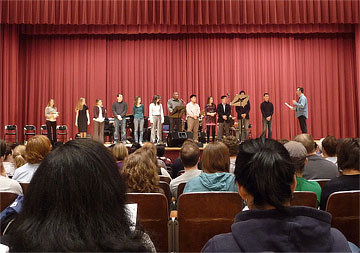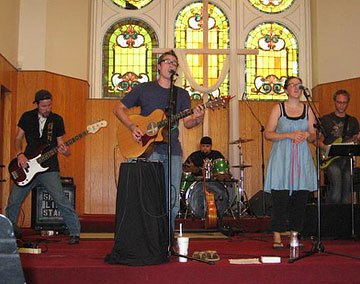During a recent visit to New York, I had the opportunity to visit Redeemer Presbyterian Church. It was my first time at Redeemer, and I was pleased to join the congregation at one of its several Sunday worship services. I had heard about this church for years, and knew that it is one of the most influential and highly-regarded churches in America. Redeemer’s senior pastor, Timothy J. Keller, is one of the most respected pastors in the country as well. So I was eager to “check out” Redeemer. Why, I wondered, is this church thriving in the midst of New York City? . . . which is not exactly the Bible belt.
Before I offer some observations on why Redeemer is making such an impact, both in New York City and throughout the country, I’d like first to set up my thoughts by giving a bit of history and describing my visit to the church.
Redeemer Presbyterian Church, a congregation in the Presbyterian Church of America, a more conservative denomination than the PCUSA, was founded in 1989. Under the pastoral guidance of Tim Keller, the church has grown amazingly during the past two decades. It draws well over 4,000 people to worship each week, and has planted dozens of new churches in the New York City area. Redeemer has inspired other “Redeemer” church plants across the country, and has set an example for hundreds of other churches that are seeking to impact the cities in which they have been planted.
Here is Redeemer’s vision statement as found on its website:
To spread the gospel, first through ourselves and then through the city by word, deed, and community; To bring about personal changes, social healing, and cultural renewal through a movement of churches and ministries that change New York City and through it, the world.
I attended one of Redeemer’s five Sunday worship service, the 6:00 p.m. East Side Evening Worship at the Hunter College auditorium, a large venue that seats just over 2,000 people. It was a cold and rainy evening, but that didn’t stop well over 1,000 people from gathering for a 75-minute worship service.
The Hunter College auditorium, not surprisingly, did not feature any religious art or symbols. The church did not add any, at least not anything that I could see. In fact, other than the praise band set up on the stage and the nicely-printed bulletin handed out to all participants, the Redeemer worship service did not include any visual components: no religious symbols displayed, no artwork, no digital projection.
When we arrived at the auditorium, we were greeted by a friendly but not too-friendly person who welcomed us and gave us some material about the church. Because we were a half-hour early, we found our own seats, and were not escorted by an usher. As the people gathered, I was struck by their friendliness to each other. Nobody spoke to me and my family, however, until an official time of greeting in the service. Most of the people who gathered seemed happy to talk with their friends, or to sit quietly as they waited for the service to begin.
 In most churches I attend, and I visit quite a few these days, there is no shortage of white hair in the pews. At Redeemer, I was one of few who had white hair. (Tim Keller seems to have white hair, but mostly he has none.) The photo to the right shows a group of new members who were received that night. Though the picture is small, you can tell that the average age of these people appears to be late 20s. You’d also see some ethnic diversity, with a few Asian folk and one African-American, in addition to several Anglos. You won’t see any people over forty in the congregation, either. I don’t know whether Redeemer’s other worship services include more older people. But it is striking that this church includes so many younger folk, especially given the nature of the worship service, as I’ll explain in a moment.
In most churches I attend, and I visit quite a few these days, there is no shortage of white hair in the pews. At Redeemer, I was one of few who had white hair. (Tim Keller seems to have white hair, but mostly he has none.) The photo to the right shows a group of new members who were received that night. Though the picture is small, you can tell that the average age of these people appears to be late 20s. You’d also see some ethnic diversity, with a few Asian folk and one African-American, in addition to several Anglos. You won’t see any people over forty in the congregation, either. I don’t know whether Redeemer’s other worship services include more older people. But it is striking that this church includes so many younger folk, especially given the nature of the worship service, as I’ll explain in a moment.
The worship service began shortly after 6:00 p.m. with a jazz prelude. (Yes, it was called a “Prelude” in the bulletin.) Then one of the associate pastors, Matthew Paul Buccheri, came out to welcome us and call us to worship. He was a relatively young man (under 40, I think) with a New York accent. He wore a tie, but his shirt was untucked. His style was relaxed, but not overly casual. He didn’t tell jokes or warm up the crowd. Rather, he called us to worship in a theologically-solid statement of who God is and what worship is all about. There was an element of explantion in his preparatory comments, as if he was helping us understand what was coming so that we might participate.
The bulk of the worship time, prior to the sermon, included the singing of a variety of songs. There was a faint memory of the jazz feel of the prelude, but, for the most part, the worship band sounded like most other top-drawer worship bands I’ve heard. The main leader was a woman, who was joined by the associate pastor in leading the singing.
Most of the songs and hymns of worship were familiar to me, including: “How Great is Our God,” “Come Let Us Worship and Bow Down,” “Ancient of Days,” “He Knows My Name,” and “The Church’s One Foundation.” It struck me that only “How Great is Our God” was written within the last decade. “Come Let Us Worship and Bow Down” is a classic praise song, having been published thirty years ago. I was singing this song in worship before most of the people in the Hunter College auditorium were born. As I’ve mentioned before, there was no digital projection of lyrics. They were printed in the bulletin. Quite clearly, there was nothing especially fancy or trendy or edgy about the musical portion of the worship at this Redeemer service, other than the unusual Jazz prelude (and postlude).
In my next post on Redeemer I’ll describe the sermon preached by Tim Keller. Then I’ll offer some observations on why this church is so successful, not only in terms of numbers, but also in terms of influence.

